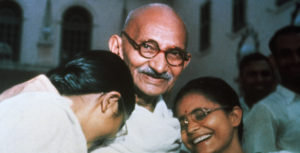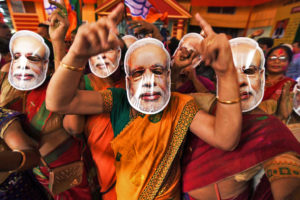Liberals are livid. Ban the film, they say. It’s Islamophobic dross. India’s current ruler Narendra Modi, meanwhile, has waxed lyrical about The Kerala Story, a film about a Hindu woman hoodwinked into joining Isis. His praise has only intensified liberal vehemence. The opposition-controlled government of West Bengal has heeded the critics and yanked the film off cinema screens, whereas Modi’s minions in Madhya and Uttar Pradesh have waived the ticket tax to draw in the teeming masses.
And so India’s culture wars wearily carry on, pitching liberal secularists against Hindu nationalists yet again. This particular battle has already claimed its first life in Maharashtra: a 40-year-old electrician died in a stone-pelting contest provoked by an Instagram post about the indie drama. Meanwhile, 20-somethings at a Jammu hostel pummelled one another into hospital beds, after one of them voiced the rather outré opinion that the film was “worth watching”.
It most certainly wasn’t. It’s 138 minutes of my life that I will not get back. Here is a production that falls into the dominant genre in contemporary Indian filmmaking: the deranged docudrama. Militarism and a muscular Hinduism, ChatGPT scriptwriting and CGI cinematography, combine in these epic fantasies of unblushing Modi-ana, as myriad villains get their comeuppance: Muslim militants in The Kashmir Files, Pakistanis in Uri: The Surgical Strike, opposition parties in The Accidental Prime Minister, and all three in the biopic, PM Narendra Modi.
In The Kerala Story, Muslim fundamentalists are once again the villains of the piece. The theme is “love jihad”, an oxymoronic term that refers to a conspiracy theory now ubiquitous in India. Lascivious Muslim men, so Modi’s publicists have it, are seducing unsuspecting Hindu women only in order to convert them and increase the number of Muslim babies. This is the Indian version of the Great Replacement Theory, pedalled by the ruling BJP. Muslims are conspiring to become a majority, the argument goes, in order to impose sharia rule on Hindus and, ultimately, obliterate Hinduism altogether.
The director Sudipto Sen’s sleight of hand is to weld love jihad with another Hindu nationalist bugbear: actual jihad. So, we find Shalini, the tragic heroine, abandoning her nursing degree to take up with a Muslim man, who carries her away to an Isis boot camp in the Afghan desert. Her fate as a suicide bomber destined for Syria seems sealed. But then — spoiler alert — a drone, the deus ex machina of our times, spots her. She is whisked away to a Gitmo-style military prison, where she spills the beans about a ginormous terror network set on converting and killing Hindus in their millions. So far, so trite. So why are liberals up in arms?
Sen’s spurious statistics, together with the echolalia of the unthinking press, seem to be the main source of outrage. Shalini has it that 32,000 Hindu women from Kerala, all victims of “love jihad”, lie buried in the sands of Syria. In interviews, Sen has stood by that number. Maths clearly isn’t his forte. Only around 500 Hindus convert to Islam every year — generally not to become Isis fighters but, in the main, to marry outside their faith. (At its peak in 2017, Isis counted a mere 37 Keralite recruits and sympathisers, as a convincing database put together by Sara Perlangeli and Dhruva Jaishankar shows.) But liberals need not worry about Sen’s trouble with numbers — or, indeed, his trouble with Muslims. For as propaganda goes, The Kerala Story is piss-poor. If anything, it reflects worse on Hindus than Muslims.
In fact, what the film does is show why it is so easy to convert Hindus. The impetus for Shalini’s conversion betrays not so much the pull of Islam as the push of Hinduism. Flashbacks reveal a life of stifling domesticity and sexual harassment. Evidently, Hindu patriarchy didn’t have much to recommend it. The same goes for the individualistic vacuity of Hindu family life, an instructive contrast with the communal conviviality of its Muslim counterpart.
Shalini, admittedly, might be overreading things here. If Muslim families seemed closer to her, it is because, generally speaking, Muslims in India are poorer than Hindus, and richer Indians have a preference for nuclear over extended families. Likewise, if Hindu women — in her experience — were more likely to be pawed and groped in shopping malls, it is largely because they are more likely to come out of the confines of the home. Nevertheless, Shalini is smitten by the pedestrian theology of her pious Muslim roommate, Asifa. The naughty gods of Hinduism, about as craven and lustful as in the Greek epics, are no match for the pensive prophet. And when Asifa throws a hijab over Shalini’s head, ridding her of unwanted male attention, the good Hindu girl is lost. So utterly convinced is Shalini of Islam’s virtues that not even ludicrously grim jihadists gleefully cutting up bodies and dismembering women for wearing lipstick can shake her faith. That this is how Hindu nationalists choose to depict women — by turns credulous and treacherous — is revealing.
Something, one suspects, is rotten in the state of Hinduism. Bhimrao Ramji Ambedkar, the Dalit architect of India’s constitution, put his finger on it in 1956, the last year of his life. After decades spent trying to reform religion, it dawned on him that women and the lower orders got a raw deal not because of the corruptions of Hindu belief but rather because of Hindu belief itself. It was, above all, a doctrine of “graded inequality”, a social order held together by “an ascending scale of hatred and a downward scale of contempt”. There was no more to it. He converted to Buddhism, as do thousands of Dalits every year on the anniversary of his birth.
The Hindu obsession with conversion, then, speaks to a constant source of insecurity among its believers. The system works only so long as everyone accepts their station, which is why, when even a few leave the fold, it sets off a moral panic. During the colonial period, the threat stemmed from that adventitious agent of emancipation, Christianity. A vestigial fear of the faith remains central to Hindu nationalist thought today, church burnings being common enough in the eastern tracts of India. But over the past 100 years or so, it was instead Islam that frightened the living daylights of caste Hindus, as I argue in my book Another India.
Indeed, the very origins of Modi’s BJP lie in the fear of conversion. Its parent organisation, the Sangh Parivar, was born in the Twenties out of panic about lower caste conversions to Islam and Christianity. Most spectacularly, in 1981, more or less coinciding with the birth of the BJP, an entire village of Dalits embraced Islam. Class politics in India always needs to find a religious register. At the outset, these Dalits had contemplated converting to Buddhism before deciding against it, Islam being the epitome of subalternity. The shock of Islam was designed to draw Delhi’s attention to the injustices of the caste system as well as the enormity of state neglect.
In response, Brahmins embraced proselytisation — historically alien to Hinduism. Missionary orders were set up and converts won in elaborate shuddhi — purification — ceremonies. More recently, Modi’s reign has been coeval with the Ghar Wapsi campaign, a concerted drive to, as it were, “return” converts back to the House of Hinduism. Christians and Muslims are won over, often under duress, to their “true” faith, their foreign-sounding names replaced with suitably Hindu ones.
The war against “love jihad” is of a piece with this vision. Starting in the late 2000s, Hindu nationalists set about cracking down on miscegenation. These days, marauding gangs break up mixed couples in ice-cream parlours, cinema halls, and even register offices, forestalling marriages in the nick of time. It’s an uphill struggle, but Hindu nationalists seem to be winning. Interfaith relationships are on the decline.
All the same, and perhaps counterintuitively, liberals ought to take comfort from films like The Kerala Story. Sure, it offends the viewer’s intelligence, but I’m not convinced that the film should be banned because it offends Muslims. For in carping about conversion, not least the effortlessness with which it is secured, Sen and his ilk are unwittingly making the case against Hindu hierarchy: exposing the very real factors that push people away from the nationalists’ faith, rather than confirming the conspiracy theory about Islamism. Here, then, is a truth about Hindu nationalism. It’s brutally effective when violently evangelised, but the minute it tries to persuade, its propaganda goes hopelessly awry.
Disclaimer
Some of the posts we share are controversial and we do not necessarily agree with them in the whole extend. Sometimes we agree with the content or part of it but we do not agree with the narration or language. Nevertheless we find them somehow interesting, valuable and/or informative or we share them, because we strongly believe in freedom of speech, free press and journalism. We strongly encourage you to have a critical approach to all the content, do your own research and analysis to build your own opinion.
We would be glad to have your feedback.
Source: UnHerd Read the original article here: https://unherd.com/



